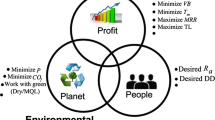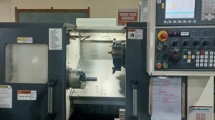Abstract
To improve the machinability of Inconel 718, a lot of work has been done in the past decade by modifying tools and machining processes. However, a recently developed cryogenic-ultrasonic assisted turning (CUAT) process influencing the machinability of Inconel 718 as compared to the conventional turning process (CT) has not been conspicuously presented. This paper analyzes the machinability of Inconel 718 using indigenously developed ultrasonic assisted turning (UAT) and CUAT facilities. The influence of the UAT process of Inconel 718 on cutting parameters recommended by the industry has been investigated. Surface roughness (Ra) and power consumption are measured under the UAT process and then compared with the CT process. Particle swarm optimization (PSO) algorithm is used to identify the optimum cutting parameters to achieve minimum Ra and power consumption for UAT and CT processes. The optimized parameters are considered to confirm the usefulness of CUAT as compared to UAT and CT processes. Experimental results of this research work endorse positive effects of the CUAT process over UAT and CT processes in terms of Ra and chip morphology. Ra values under the CUAT process are reduced significantly in comparison to UAT and CT processes, respectively. UAT and CUAT processes resulted in discontinuous chips having smaller chip thickness in comparison to the CT process. The results are being shared with the local SMEs, and the industry is anticipated to be benefited in terms of improving cutting performance using CUAT and UAT. Moreover, a sustainability assessment model is implemented to investigate the effect of CUAT in terms of machining performance as well as sustainability effectiveness in a single integrated approach.









Similar content being viewed by others
Abbreviations
- CT :
-
Conventional turning
- UAT :
-
Ultrasonic assisted turning
- CUAT :
-
Cryogenic-ultrasonic assisted turning
- v c :
-
Cutting speed in m/min
- f r :
-
Feed in mm/rev
- f :
-
Frequency in kHz
- a p :
-
Depth of cut in mm
- R a :
-
Average surface roughness in μm
- DoE :
-
Design of experiments
- rpm :
-
Revolutions per minute
- LN 2 :
-
Liquid nitrogen
- TWCR :
-
Tool-workpiece contact ratio
- TWSI :
-
Total weighted sustainable index
References
Anbarasan N, Jerome S, Suresh G, Oyyaravelu R (2019) Effect of pulse frequency on microstructural and corrosion properties of Inconel 718 gas tungsten arc weldments. Trans Indian Inst Metals 72(5):1299–1311
Wang X, Huang C, Zou B, Liu G, Zhu H, Wang J (2018) Experimental study of surface integrity and fatigue life in the face milling of Inconel 718 front. Mech Eng 13:243–250
Thirumalai R, Senthilkumar JS (2013) Multi-criteria decision making in the selection of machining parameters for Inconel 718. J Mech Sci Technol 27(4):1109–1116
Akhtar W, Sun J, Sun P, Chen W, Saleem Z (2014) Tool wear mechanisms in the machining of nickel based super-alloys : a review front. Mech Eng 9:106–119
Shokrani A, Dhokia V, Newman ST, Imani-Asrai R (2012) An initial study of the effect of using liquid nitrogen coolant on the surface roughness of Inconel 718 nickel-based alloy in CNC milling. Procedia CIRP 3(1):121–125
Devillez A, Schneider F, Dominiak S, Dudzinski D, Larrouquere D (2007) Cutting forces and wear in dry machining of Inconel 718 with coated carbide tools. Wear 262(7–8):931–942
Silberschmidt VV, Mahdy SMA, Gouda MA, Naseer A, Maurotto A, Roy A (2014) Surface-roughness improvement in ultrasonically assisted turning. Procedia CIRP 13:49–54
Xu S, Kuriyagawa T, Shimada K, Mizutani M (2017) Recent advances in ultrasonic-assisted machining for the fabrication of micro/nano-textured surfaces front. Mech Eng 12:33–45
Sharma V, Pandey PM (2016) Recent advances in ultrasonic assisted turning: a step towards sustainability. Cogent Eng 3(1):1–20
Wang Q, Wu Y, Gu J, Lu D, Ji Y, Nomura M (2016) Fundamental machining characteristics of the in-base-plane ultrasonic elliptical vibration assisted turning of Inconel 718. Procedia CIRP 42:858–862
Maurotto A, Muhammad R, Roy A, Babitsky VI, Silershmidt VV (2012) Comparing machinability of Ti-15-3-3-3 and Ni-625 alloys in Uat. Procedia CIRP 1:330–335
Muhammad R, Ahmed N, Roy A, Silberschmidt VV 2012 Turning of advanced alloys with vibrating cutting tool. In: Solid State Phenomena. Trans Tech Publ., 277–284
Chen DY, Tsao CC, Lin MY, Tsai CH, Hsu CY 2012 Ultrasonic-assisted on the turning of Inconel 718 by Taguchi method. In: Advanced Materials Research. Trans Tech Publ., 160–73
Lin SY, Chung CT, Cheng YY 2011 Combination of ultrasonic vibration and cryogenic cooling for cutting performance improvement of Inconel 718 turning. In: AIP Conference Proceedings, 1163–1168
Nath C, Rahman M (2008) Effect of machining parameters in ultrasonic vibration cutting. Int J Mach Tools Manuf 48(9):965–974
Ahmed N, Mitrofanov AV, Babitsky VI, Silberschmidt VV (2006) Analysis of material response to ultrasonic vibration loading in turning Inconel 718. Mater Sci Eng A 424(1–2):318–325
Xavior MA, Patil M, AbheekMaiti RM, Lohia N (2016) Machinability studies on INCONEL 718. IOP Conf Ser Mater Sci Eng 149:12–19
Bhanot N, Rao PV, Deshmukh SG (2015) Sustainable manufacturing: an interaction analysis for machining parameters using graph theory. Procedia Soc Behav Sci 189:57–63
Pusavec F, Deshpande A, Yang S, M’Saoubic R, Kopac J, Jawahir IS (2015) Sustainable machining of high temperature nickel alloy – Inconel 718: part 2 – chip breakability and optimization. J Clean Prod
Khanna N, Agrawal C, Joshi V 2017 Zero vapor loss integrated cryogen phase separator. Indian Patents, 201721031291 A
Musfirah AH, Ghani JA, Haron CC (2017) Tool wear and surface integrity of Inconel 718 in dry and cryogenic coolant at high cutting speed. Wear 376–377:125–133
Khanna N, Suri N, Agrawal C, Shah P, Krolczyk GM (2019) Effect of hybrid machining techniques on machining performance of in-house developed mg-PMMC. Trans Indian Inst Metals
Khanna N (2016) Design of experiments in titanium metal cutting research. In: Design of experiments in production engineering. Springer, Cham, pp 165–182
Khanna N, Davim JP (2015) Design-of-experiments application in machining titanium alloys for aerospace structural components. Meas J Int Meas Confed 61:280–290
Krishnaiah K, Shahabudeen P (2012) Applied design of experiments and Taguchi methods. PHI Learning Pvt Ltd., New Delhi
Cartigueyen S, Mahadevan K (2019) Effects of thermal conditions on microstructure and mechanical properties of cu–SiCp surface nanocomposites by friction stir processing route. Trans Indian Inst Metals 72(2):289–305
Gupta MK, Sood PK, Sharma VS (2016) Optimization of machining parameters and cutting fluids during nano-fluid based minimum quantity lubrication turning of titanium alloy by using evolutionary techniques. J Clean Prod 135:1276–1288
Chen X, Wang S, Qiao B, Chen Q (2018) Basic research on machinery fault diagnostics : past, present, and future trends front. Mech Eng 13:264–291
Pusavec F, Hamdi H, Kopac J, Jawahir IS (2011) Surface integrity in cryogenic machining of nickel based alloy—Inconel 718. J Mater Process Technol 211(4):773–783
Kaynak Y, Karaca HE, Noebe RD, Jawahir IS (2013) Tool-wear analysis in cryogenic machining of NiTi shape memory alloys : a comparison of tool-wear performance with dry and MQL machining. Wear 306:51–63. https://doi.org/10.1016/j.wear.2013.05.011
Kumar R, Sahoo AK, Mishra PC et al (2018) Adv Manuf 6:52. https://doi.org/10.1007/s40436-018-0215-z
Sahoo AK, Sahoo AK, Mohanty T et al (2013) Optimization of multiple performance characteristics in turning using Taguchi’s quality loss function: an experimental investigation. Int J Ind Eng Comput 4(3):325–336
Khanna N, Agrawal C, Gupta MK, Song Q (2019) Tool wear and hole quality evaluation in cryogenic drilling of Inconel 718 superalloy. Tribol Int. https://doi.org/10.1016/j.triboint.2019.106084
Merchant ME (1945) Mechanics of the metal cutting process. I. Orthogonal cutting and a type 2 chip. J Appl Phys 16(5):267–275
Molinari A, Musquar C, Sutter G (2002) Adiabatic shear banding in high speed machining of Ti – 6Al – 4V : experiments and modeling. Int J Plast 18:443–459
Kaynak Y (2014) Evaluation of machining performance in cryogenic machining of Inconel 718 and comparison with dry and MQL machining. https://doi.org/10.1007/s00170-014-5683-0
Taylor P, Machining F, Kaynak Y, Lu T, Jawahir IS. Machining science and technology : an cryogenic machining-induced surface integrity : a review and comparison with n.d.:37–41
Hegab HA, Darras B, Kishawy HA (2018) Towards sustainability assessment of machining processes. J Clean Prod 170:694–703
Narita H, Desmira N, Fujimoto H (2008) Environmental burden analysis for machining operation using LCA method. In: Manufacturing Systems and Technologies for the New Frontier. Springer, London, pp 65–68
Acknowledgments
The authors are thankful to the SERB-DST, Government of India, for providing financial aid under the project no. ECR/2016/000735, titled “Design and Development of Energy Efficient Cryogenic Machining Facility for Heat Resistant Alloys and Carbon Fibre Composites”. The authors also acknowledge the assistance of Mr. Jay Airao during experimentation.
Author information
Authors and Affiliations
Corresponding author
Additional information
Publisher’s note
Springer Nature remains neutral with regard to jurisdictional claims in published maps and institutional affiliations.
Rights and permissions
About this article
Cite this article
Khanna, N., Shah, P., Agrawal, C. et al. Inconel 718 machining performance evaluation using indigenously developed hybrid machining facilities: experimental investigation and sustainability assessment. Int J Adv Manuf Technol 106, 4987–4999 (2020). https://doi.org/10.1007/s00170-020-04921-x
Received:
Accepted:
Published:
Issue Date:
DOI: https://doi.org/10.1007/s00170-020-04921-x




